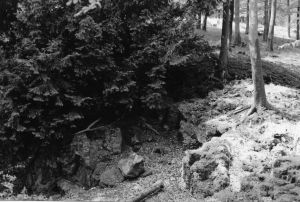|
In the Spring of 2004 Gloucestershire Wildlife Management Limited, acting under the auspices of the Gloucestershire Wildlife Trust, invited myself and an arachnologist friend, David Haigh, to make 10 recording visits over two years to “scowles” sites in the Forest of Dean in west Gloucestershire all in vice county 34.We worked together, but others made separate visits to cover habitat, mosses and liverworts and bats. Although the survey was originally intended to cover both Forest Enterprise and privately owned sites only Forest Enterprise sites were visited. Scowles are excavations, some going back to Roman times, to recover iron minerals from solution hollows in early Carboniferous rocks especially the Crease Limestone, but also other rocks such as the Drybrook Sandstone. [1] The scowles closely follow the narrow outcrop of these rocks which surrounds the late Carboniferous sandstones and coals of the central Forest of Dean, from roughly Lydney Park up to the Wigpool area and south again to near Blakeney.The diggings now appear in various forms, from shallow soil and leaf litter filled hollows to holes with prominent rocks and sometimes cave entrances.Vegetation in and around the scowles varies from deciduous woodland to conifer plantations (and occasionally open sites). Recent quarrying is also often associated with these early Carboniferous rocks. We were supplied with a set of 1:5000 Ordnance Survey-based maps on which scowles and quarries had been marked by Gloucestershire County Council Archaeology Service with colour outlines indicating whether they were in Forest Enterprise or in private ownership. Using these maps, sites were selected for fieldwork, with a bias away from conifer plantations and were also chosen to ensure sampling of the overall geographical spread of the scowles. On site searches were made of litter, using sieves in dry conditions, ground vegetation (sweeping), visual searches of tree trunks, rocks, rock faces and herbage and sweep netting and beating of herbage and foliage. Rocks and stones were turned over and replaced. Search duration varied.We did not enter caves. Molluscs were identified in the field. Three freshwater and 52 land mollusc species were recorded. One of these species, the Slender slug, Malacolimax tenellus, is a Species of Conservation Concern in the UK Steering Groups Biodiversity Action Plans and it is also Nationally Notable [2]. In general the fauna mostly consists of species typical of woodland, and it includes 5 species typical of old woodlands – the Nationally Notable Greater pellucid glass snail Phenacolimax major, the Ash-black Slug Limax cinereoniger, the Slender slug, Malacolimax tenellus, the Point snail Acicula fusca, and the Brown snail Zenobiella subrufescens. The occurrence of these within or very near to Scowles excavations shows they can in time re-colonise disturbed ground to some extent. Common elements in the assemblage were Carychium tridentatum (not in acid sites), Discus rotundatus,Arionid and other slugs, and Zonitid glass snails. Of the last the Glossy glass snail Oxychilus helveticus was found only on the west side of the Forest, near the Wye; this matches older records. Species mainly associated with humanly disturbed ground and gardens did not turn up often; there were at most two records each for Milacid slug species, the Strawberry snail, Trichia striolata and the Garden snail Helix aspersa. The best demonstration of the link between the local geology and molluscs occurred in the Old Staple Edge area (SO/64.10.- 65.10). Here there is a clear contrast between the limited mollusc fauna in the Oak and Beech areas and the much more diverse assembly in the scowle pits.This must be related to the contrasts in the geology between the limestones, which had contained sought after minerals, and the acid rocks of the surrounding areas.The acid fauna (11 species recorded under Beech, and 7 under Oak, in May 2005) includes the old woodland indicator slugs Limax cinereoniger and Malacolimax tenellus and Zonitoides excavatus, the only exclusively calcifuge woodland snail in the British fauna.The scowles themselves had 17 species recorded in May 2005 including another old woodland species Acicula fusca which was found in one scowle No molluscs were exclusive to scowles.Two species typical of rock faces and, scree and walls, the Lesser bulin, Merdigera obscura, and the Lesser chrysalis snail, Lauria cylindracea were found associated with vegetation near/on rock faces (the former also occurred on tree trunks) and rubble. Very many thanks to Jeremy Doe of Gloucestershire Wildlife Management Limited (GWML) for approaching us to do this work and to Forest Enterprise for giving permission for entry on to their land and to David Haigh for doing nearly all the driving and finding most of the uncommon molluscs as well as the spiders. Detailed records have been passed to GWML (for among others the Gloucestershire Environmental Records Centre) and to the Conchological Society’s Non-marine Recorder. |
Fig 1 (Photo David Long) |
A Survey in the Forest of Dean
Issue
10
Page
20

